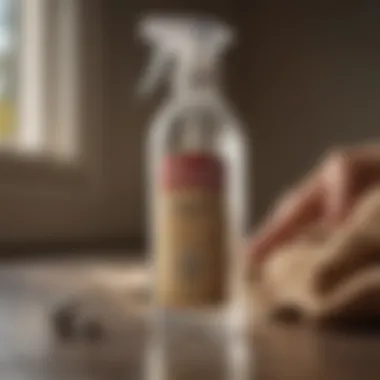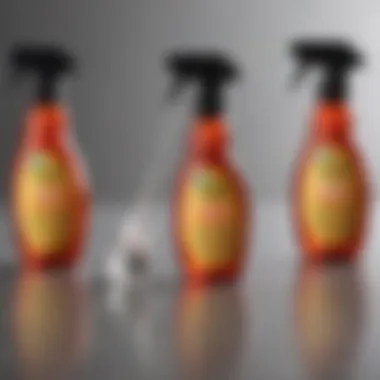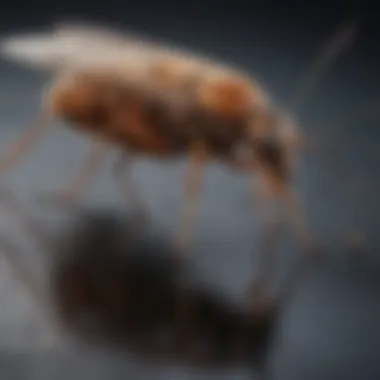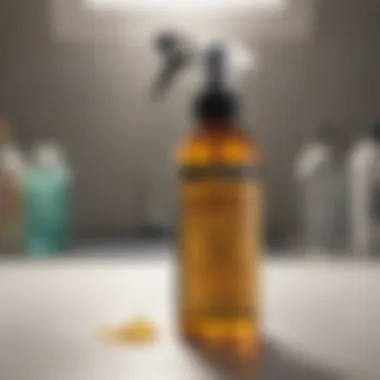Adams Flea and Tick Home Spray: Side Effects Explained


Intro
In today’s households, pests such as fleas and ticks can become a significant concern. These tiny creatures not only irritate pets, but they can also pose health risks to humans. Consequently, understanding the potential risks associated with pest control products like Adams Flea and Tick Home Spray becomes crucial. This article examines possible side effects of the product while considering its composition and intended benefits.
Identification of Common Pests
Description of Common Pests
Fleas and ticks are prevalent in many homes. Fleas are small, wingless insects that feed on the blood of their hosts, mainly cats and dogs. They can jump great distances, allowing them to spread rapidly. On the other hand, ticks are arachnids that latch onto animal hosts to feed. They thrive in grassy and wooded areas and can transmit serious diseases, such as Lyme disease. Understanding these pests is key to effective management.
Signs of Infestation
Identifying an infestation early can prevent more serious issues. Here are some common signs:
- Fleas: Excessive scratching by pets, flea dirt (which looks like black specks), and flea eggs, which are tiny and white, might be visible.
- Ticks: Pets may develop lumps or experience redness around the areas where the tick has attached. Check for ticks after outdoor activities.
Prevention Techniques
Home Maintenance Tips
Preventive measures can be more effective than treatments. To keep fleas and ticks at bay, try the following:
- Regularly wash bedding and pet accessories.
- Vacuum carpets and furniture frequently, focusing on corners and edges.
- Seal any cracks or openings in walls to reduce pest entry points.
Environmental Modifications
Making changes to the environment can also dissuade pests. Consider these modifications:
- Keep your lawn trimmed to decrease tick habitats.
- Remove clutter where pests could hide.
- Consider installing insect screens on doors and windows to create a barrier against entry.
Eco-Friendly Pest Control Options
Natural Pesticides
For those who prioritize ecological safety, there are natural pesticide alternatives. Some options include:
- Diatomaceous earth, which is a fine powder that can kill fleas.
- Essential oils like lavender or peppermint can deter pests naturally.
Organic Pest Control Techniques
Utilizing organic methods can be effective in controlling infestations without harsh chemicals. Recommended techniques include:
- Implementing pest traps throughout the home to capture and monitor pest activity.
- Promoting a healthy yard ecosystem, which can keep pests in check naturally.
Always consider the safety and wellbeing of your family and pets when selecting pest control measures.
Closure
Understanding the potential side effects of products like Adams Flea and Tick Home Spray is essential. By recognizing common pests, taking preventive measures, and exploring eco-friendly options, homeowners can create a safe and pest-free environment. This knowledge empowers families to make informed decisions about pest control in their homes.
Prelims to Adams Flea and Tick Home Spray
The management of pests in household environments is not just a matter of convenience; it is a pressing health concern for many families. Among the various options available to combat fleas and ticks, Adams Flea and Tick Home Spray has emerged as a popular choice. This article explores its purpose, common applications, and potential side effects, offering a comprehensive view of its use and efficacy.
Purpose of the Product
Adams Flea and Tick Home Spray is specifically formulated to target and eliminate common household pests. The primary aim here is to provide a swift and effective solution to keep homes pest-free.


This product contains several active ingredients that work together to kill fleas and ticks at different life stages, including eggs, larvae, and adults. As a result, it helps to break the life cycle of these pests. Moreover, many users appreciate its ease of application, allowing for a quick and organized response to a pest infestation. Understanding the purpose of this product is crucial for homeowners who are seeking effective pest management without resorting to more drastic measures.
Common Usage Scenarios
The versatility of Adams Flea and Tick Home Spray allows it to be used in various scenarios. Households with pets are the primary users, as fleas and ticks often travel from outdoor environments. Pet owners should also be aware that these pests can inhabit carpets, upholstery, and even bedding.
Additionally, this spray can be used in outdoor spaces, such as patios and yards, to create a barrier that deters pests from re-entering the home. The importance of proper application cannot be overstated. Homeowners should read the instructions to avoid any mistakes that might undermine the product’s efficacy.
Common situations include:
- Treating carpets and rugs where pets frequently dwell.
- Spraying furniture that pets may come into contact with.
- Managing outdoor areas that may attract ticks and fleas, especially in warmer months.
Users are encouraged to regularly monitor their environments and repeat treatments as necessary to maintain a pest-free space.
Chemical Composition of Adams Home Spray
Understanding the chemical composition of Adams Flea and Tick Home Spray is crucial. The effectiveness of any pest control product lies in its ingredients. Knowing these can help users make informed choices about their home environment. Moreover, understanding the components allows for better safety practices, especially when pets and young children are involved.
Active Ingredients
Adams Flea and Tick Home Spray primarily contains active ingredients designed to target and eliminate fleas and ticks. These ingredients are responsible for the product's effectiveness. One significant active ingredient is S-Methoprene, an insect growth regulator. This compound disrupts the life cycle of fleas and prevents them from maturing into adults. Additionally, Permethrin is often included. It is a synthetic chemical that acts as a potent insecticide. Both these ingredients work in tandem to offer a comprehensive approach to flea and tick control.
It is important to note that these active ingredients, while effective, can also raise concerns for some users. The potential side effects from these ingredients can lead to adverse reactions if not used properly.
Inert Ingredients
In addition to active components, Adams Flea and Tick Home Spray also includes inert ingredients. These are not biologically active but serve important purposes, such as assisting in the stability and efficacy of the spray. Ingredients like water and certain solvents facilitate the even distribution of active compounds while ensuring the product is safe for application on various surfaces.
These inert ingredients, though often overlooked, can influence how the active ingredients interact. For instance, some solubilizers might help the active ingredients penetrate surfaces better. Understanding the role of these ingredients is key when considering how the product performs under different circumstances.
"Knowing both active and inert ingredients can aid in risk assessment of the product."
Assessing Safety: Regulatory Overview
Understanding the safety of pest control products is vital for homeowners, especially when children, pets, and the environment are involved. This section will discuss the regulatory frameworks that assess the safety of Adams Flea and Tick Home Spray. It sheds light on guidelines from the Environmental Protection Agency and industry standards. Familiarity with these regulations can help consumers make informed choices.
Environmental Protection Agency Guidelines
The Environmental Protection Agency (EPA) plays a crucial role in ensuring that pesticide products like Adams Flea and Tick Home Spray meet safety standards before they can be sold. The EPA rigorously evaluates the health and environmental risks associated with these products. The agency requires that all active ingredients be tested for toxicity and potential side effects before they earn registration. This system is designed to protect both users and non-target organisms, ensuring that pesticides do not pose unreasonable risks.
Homeowners should be aware that the EPA also mandates that manufacturers provide clear labeling. This labeling includes proper usage instructions, safety precautions, and information on potential side effects, ensuring consumers are well-informed. Understanding these guidelines ensures that homeowners use the product responsibly and minimize any risks associated with its application.
Industry Standards for Pest Control Products
Beyond EPA regulations, there are also industry standards that govern the formulation and use of pest control products. Organizations such as the American Chemical Society and the National Pest Management Association help establish best practices for the industry. These standards focus on ensuring effectiveness, user safety, and environmental sustainability.
Manufacturers like Adams often comply with these guidelines, which encourage responsible use of chemicals and promote research into safer alternatives. It ensures pest control solutions are effective without compromising safety. As homeowners, awareness of these standards helps in recognizing reputable products.
"Knowing the regulatory framework surrounding pest control products is essential for making safe choices."
As consumers navigate through safety considerations, understanding the regulations and standards contributes to better decision-making in pest management strategies.
Potential Side Effects of Adams Home Spray
Understanding the potential side effects of Adams Flea and Tick Home Spray is crucial for anyone considering its use. This section aims to provide detailed insights into how this product may impact pets, humans, and the environment. Being informed about these aspects helps users to make enlightened choices regarding pest control strategies, ensuring they safeguard both their home and its inhabitants. The information presented here includes not only common reactions observed from the spray but also an analysis based on user experiences and scientific understanding.
Effects on Pets
The primary concern for pet owners using Adams Flea and Tick Home Spray is the well-being of their pets. Generally, the product is designed to be effective against fleas and ticks, yet pets may still experience adverse reactions. Common effects observed in animals include skin irritations, allergic reactions, and in some cases, symptoms of nausea or lethargy.


It is advised to monitor pets closely after spraying the product in their vicinity. If any unusual behavior is noticed, such as excessive scratching, vomiting, or restlessness, it is advisable to consult a veterinarian promptly. Always ensure that pets are kept away from areas treated until it is fully dry. Proper application can diminish risks significantly.
Effects on Humans
Human exposure to Adams Flea and Tick Home Spray can lead to various effects, particularly in sensitive individuals. Reports suggest that some users have experienced respiratory issues, skin allergies, or eye irritation upon contact with the spray. Those with pre-existing sensitivities may find these effects more pronounced.
To mitigate risks, it is essential to wear protective gear during the application process. Following the manufacturer’s instructions precisely is critical in reducing the chances of such side effects. Moreover, ensuring adequate ventilation in treated spaces can help in minimizing exposure. It is recommended to wash hands thoroughly after application to avoid unintentional contact with the face or other sensitive areas.
Effects on the Environment
The environmental consequences of using Adams Flea and Tick Home Spray warrant deliberation. Being a chemical pest control product, its active ingredients may potentially harm beneficial insects and local wildlife if not used in accordance with safety guidelines. Waterways and soil can also be affected if the chemicals enter these systems through runoff.
Users should be diligent about following disposal instructions for empty containers and any residual product. Applying the spray conservatively, avoiding overuse, can aid in mitigating environmental impact. Proactive steps help not only protect local ecosystems but also ensure compliance with environmental safety standards.
"While pest control is necessary, understanding the broader implications of chemical use is essential for sustaining our environment and promoting health."
In summary, being aware of the potential side effects of Adams Flea and Tick Home Spray can empower users to make informed decisions. It is essential to balance effective pest control with the health and safety of pets, family members, and the environment.
User Experiences and Reports
Understanding the user experiences that arise from using Adams Flea and Tick Home Spray is crucial in assessing its true effectiveness and safety. This section highlights firsthand accounts that illustrate the potential benefits and drawbacks associated with the product. Assessing user experiences helps in formulating a clearer picture of how the spray performs in various home environments and among differing demographics, particularly pets and their owners.
Case Studies
Case studies provide in-depth insight into real-world applications of the Adams Flea and Tick Home Spray. For instance, one family living in a densely wooded area reported a significant reduction in flea and tick populations after treating their home with the spray. They noted that their pets appeared noticeably more comfortable, indicating the treatment's immediate effectiveness against pests.
In another instance, a homeowner who had previously used other pest control methods expressed a high level of satisfaction. This user shared that the spray did not leave a residual odor and dried quickly, allowing them to resume normal activities without prolonged interruptions. These positive case studies bolster the product's reputation as a practical solution in pest management.
Common Complaints
Despite the positive reports, there are also common complaints that users associate with Adams Flea and Tick Home Spray. A recurring issue noted by some users is skin irritation in pets shortly after application. Though not universally experienced, this concern raises questions about the sensitivity of individual animals to the active ingredients in the spray. Another frequent complaint involves the need for multiple applications to maintain effectiveness, particularly in cases of severe infestations. Users have expressed frustration over having to reapply the product more than initially anticipated.
Furthermore, certain users have documented the ineffectiveness in combating certain pest species. There are reports where individuals noticed little to no impact on specific types of ticks or fleas, leading to disappointment and a sense of wasted effort.
Positive Outcomes
On the flip side, numerous users report positive outcomes following the use of Adams Flea and Tick Home Spray. Many individuals commend the product for its ease of application. The spray mechanism allows for precise targeting of areas repeatedly visited by pests, ensuring adequate coverage. Users find this feature especially valuable when treating carpets and upholstery, where pests frequently reside.
Moreover, another highlight among favorable user experiences is the product's formulation. Several users indicated an appreciation for the absence of harsh chemical fragrances. This attribute appeals to families concerned about indoor air quality and the well-being of children and pets alike. The balance between efficiency and a user-friendly experience reflects positively on the spray’s design and packaging.
Comparative Analysis with Other Pest Control Products
Understanding how Adams Flea and Tick Home Spray fits into the broader pest control market is crucial for making smart choices. This section aims to provide clarity on how this specific product compares to others available in the market. By examining both similarities and differences, you can better evaluate which option aligns with your needs and preferences. The significance of comparative analysis lies in informed decision-making. Knowing how products stack up in terms of safety, effectiveness, and environmental impact can guide you toward a safer pest management solution.
Similar Products
In the realm of flea and tick control, numerous products provide various benefits. Some similar offerings include Ecolab Goodbye Fleas, Vet's Best Flea and Tick Home Spray, and Original Sprout Flea & Tick Foam. These alternatives often claim to be effective while targeting common household pests. Here is a snapshot of key similar products:
- Ecolab Goodbye Fleas: Effective against fleas, uses botanical ingredients.
- Vet's Best Flea and Tick Home Spray: Combines natural ingredients with proven effectiveness.
- Original Sprout Flea & Tick Foam: Offers a gentle solution suitable for sensitive skin.
Each of these products, like Adams, aims to alleviate pest issues without overwhelming chemical exposure.
Differences in Composition and Effectiveness
When evaluating differences, it is vital to note how Adams Flea and Tick Home Spray’s composition sets it apart. Its active ingredients may differ from those used in similar products, leading to variations in effectiveness. For instance, while some products rely heavily on synthetic pesticides, Adams incorporates a mix of active and inert ingredients designed to minimize harm to pets and humans.
Here are some key points to consider:


- Active Ingredients: Products may use different active ingredients such as permethrin in Adams, while others could use essential oils or other synthetic options.
- Method of Application: Some sprays come in bottles requiring manual spraying, while others might offer a residue-free treatment method.
- Duration of Effectiveness: The length of time relief lasts can vary significantly. Adams may provide long-lasting protection compared to others which require frequent applications.
Ultimately, understanding these differences can provide insight into what works best in your specific situation. It is wise to think about what is best for your household before settling on a particular pest control method.
Guidelines for Safe Use
Understanding the guidelines for safe use of Adams Flea and Tick Home Spray is essential for effective pest management in your home. The product, while intended to eliminate fleas and ticks, may also pose risks to pets, humans, and the environment if not used correctly. Following proper guidelines ensures that you achieve the desired results while minimizing any adverse effects.
Application Tips
When using Adams Flea and Tick Home Spray, adhere to the following application tips:
- Read the Label: Always begin by thoroughly reading the product label. This contains vital information about safe usage and specific instructions.
- Select the Right Time: Apply the spray when children and pets are not present. This reduces the risk of exposure to sensitive individuals.
- Test Surfaces First: Before applying on larger areas, test a small, inconspicuous spot to ensure the surface does not react negatively to the spray.
- Apply Evenly: Ensure that the spray is applied evenly across the area. Avoid saturating any one spot to prevent pooling.
- Use Protective Gear: While the spray may be safe when used as directed, consider wearing gloves and a mask during application for added protection.
Storage Recommendations
Proper storage of Adams Flea and Tick Home Spray contributes significantly to its effectiveness and safety. Keep the following points in mind:
- Store Upright: Always store the bottle upright to prevent leaks.
- Cool, Dry Place: Keep the spray in a cool, dry place, away from direct sunlight. High temperatures can degrade the effectiveness of the active ingredients.
- Out of Reach of Children and Pets: Ensure that the product is stored in a location that is not accessible to children and pets. This is critical to prevent accidental ingestion or exposure.
- Check Expiry Dates: Regularly check the expiration date on the bottle. Using an expired product may lead to ineffective pest control and potential safety concerns.
Following these guidelines will help maximize the benefits of Adams Flea and Tick Home Spray while minimizing risks associated with its use.
Always prioritize safety and proper handling to ensure the well-being of your household.
Alternatives to Chemical Treatments
The search for effective pest control method often leads people to consider both chemical and non-chemical options. Understanding alternatives to chemical treatments is essential. This allows for a more holistic approach to pest management in homes where safety is a priority.
Some households may prefer not to use products like Adams Flea and Tick Home Spray due to concerns over potential side effects. This section will explore different options to manage pests in a safer manner while still being effective.
Natural Remedies
Natural remedies are increasingly popular among homeowners who seek to avoid the side effects associated with chemical products. These remedies can range from essential oils to herbal solutions. Some of the well-known natural approaches include:
- Diatomaceous Earth: This powder, made from fossilized algae, can kill fleas and ticks upon contact. Applying it on carpets or pet bedding can prove effective. Ensure to use food grade diatomaceous earth for safety around pets and children.
- Essential Oils: Oils such as lavender, peppermint, and eucalyptus can repel pests. Cedar oil has also shown efficacy against fleas. Mixing a few drops with water and using it in a spray bottle can create an effective deterrent.
- Vinegar Solutions: A mixture of water and vinegar can be used as a natural spray. This can help in repelling fleas. However, the scent may need regular reapplication as it fades away.
Using these natural remedies can significantly lessen the chemical load in your living space. They are generally safe for pets and children. However, it's important to remember that while many of these methods can help repel pests, they may not be as potent as chemical treatments.
Preventive Measures
Preventive measures play a crucial role in pest management. By implementing a combination of strategies, homeowners can create an environment that minimizes the likelihood of flea and tick infestations.
- Regular Cleaning: Vacuuming carpets, rugs, and upholstery can help remove fleas and their eggs. Regular washing of pet bedding and toys also aids in keeping infestations at bay.
- Maintaining Yard Condition: Keep grass trimmed and remove leaf litter. Fleas and ticks thrive in dense foliage. By maintaining a clean yard, you help reduce their habitat.
- Pet Hygiene: Regular grooming and baths for pets can significantly reduce flea and tick populations. Using flea prevention products like collars or topical treatments can assist in keeping pets safe.
- Limiting Outdoor Exposure: Restricting pets from roaming in areas known for high flea and tick populations can also be an effective strategy.
In summary, a combination of natural remedies and preventive measures can provide effective alternatives to chemical treatments. Adopting these practices not only enhances safety in the home but also promotes a healthier environment.
"Opting for natural solutions often leads to safer homes while tackling pest issues effectively."
These alternatives require consistency and commitment, but they can yield favorable results without the potential side effects associated with chemicals.
Homeowners looking for efficient pest control should consider these options to find what best aligns with their values and needs.
End
In the context of pest management, understanding the potential side effects of products like Adams Flea and Tick Home Spray is crucial for making informed decisions. This article outlined key findings regarding the composition, safety, and effectiveness of this home spray, helping housewives and homeowners navigate the complexities of pest control in their environments.
Summary of Findings
This discourse illuminated various facets of Adams Flea and Tick Home Spray. The active ingredients serve their primary purpose, yet they may also induce some adverse reactions in both pets and humans. Regulatory agencies have provided guidelines aimed at ensuring safe usage. Reports from users offer a mixed bag of experiences, highlighting both effectiveness and specific concerns. Notably, it is imperative to consider not just the benefits but also the risks associated with chemical applications in the home.
"Awareness of the possible side effects paves the way for safer pest management strategies."
Final Recommendations
Based on a comprehensive analysis, several recommendations emerge. Firstly, always follow the application guidelines provided by Adams to minimize risks. Regularly assess your living environment for any adverse reactions in pets and family members post-application. Consider exploring alternative pest control methods alongside using chemical sprays. Natural remedies are effective and pose fewer risks. If side effects persist, consulting a veterinary professional or a pest control expert is advisable. Awareness and caution can build a safer home environment.







